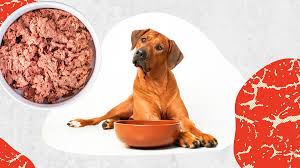Featured
- Get link
- X
- Other Apps
The Benefits of Raw Dog Food Diets
The Benefits of Raw Dog Food Diets
In recent years, the popularity of raw dog food diets has surged among pet owners looking to provide their furry companions with a more natural and wholesome nutrition option. Advocates of raw feeding, also known as the BARF diet (Biologically Appropriate Raw Food or Bones and Raw Food), argue that this diet closely resembles what dogs would consume in the wild. As with any dietary approach, it's essential to consider the potential benefits and drawbacks. However, many dog owners have found that a raw food diet can provide a variety of benefits for their pets.
1. Improved Digestion
One of the most significant advantages of raw dog food diets is improved digestion. Raw food is typically easier for dogs to digest compared to processed kibble, which can contain fillers and artificial ingredients. Many dogs experience reduced gas, bloating, and diarrhea when switched to a raw diet. Raw diets often include raw meat, bones, and organs, which are rich in natural enzymes that help break down food. Furthermore, the higher moisture content in raw food helps keep dogs hydrated and supports optimal digestive health.
2. Healthier Skin and Coat
A raw dog food diet can lead to healthier skin and a shinier coat. The natural fats found in raw meat and fish provide essential fatty acids that promote skin health. Dogs on a raw diet often show improvements in skin conditions, such as dryness or allergies, and their coats become more vibrant and less prone to shedding. The absence of artificial additives and preservatives, commonly found in commercial dog foods, reduces the risk of skin irritations and allergic reactions.
3. Increased Energy Levels
Many dog owners report that their pets exhibit increased energy levels after transitioning to a raw food diet. This improvement can be attributed to the high-quality protein and nutrient density of raw foods. Unlike kibble, which often contains grains and fillers, raw diets provide the essential nutrients dogs need to maintain energy and vitality. As a result, dogs may become more active and engaged, leading to better overall physical health.
4. Enhanced Dental Health
Raw dog food diets can also promote better dental health. Chewing raw meaty bones helps reduce plaque and tartar buildup on dogs’ teeth, leading to improved oral hygiene. The act of chewing also stimulates the gums and can help prevent gum disease. This natural approach to dental care is often more effective than commercial dental treats, which can sometimes be high in sugar or artificial ingredients.
5. Weight Management
Raw diets can be beneficial for maintaining a healthy weight in dogs. Because raw food is less processed and often contains fewer carbohydrates, it can help prevent obesity in pets. Owners can easily control portion sizes and tailor their dogs’ diets based on individual needs. Additionally, the high protein content in raw diets helps dogs feel fuller for longer, reducing the likelihood of overeating.
6. Allergies and Sensitivities
Many dogs suffer from food allergies or sensitivities, and a raw diet can be a solution. By eliminating common allergens found in commercial dog foods, such as grains, fillers, and artificial additives, pet owners can often identify and eliminate ingredients that trigger allergic reactions. This tailored approach allows for more control over what goes into a dog’s diet, leading to fewer allergic reactions and better overall health.
Conclusion
While transitioning to a raw dog food diet requires careful planning and research to ensure balanced nutrition, the potential benefits are numerous. Improved digestion, healthier skin and coat, increased energy levels, enhanced dental health, better weight management, and reduced allergies are just a few reasons why many dog owners are choosing this approach. As with any significant dietary change, it is essential to consult with a veterinarian to ensure that your pet's nutritional needs are met and to determine if a raw diet is suitable for their specific health conditions. With the right approach, a raw dog food diet can lead to a happier, healthier life for your canine companion.
- Get link
- X
- Other Apps
Popular Posts
Tips for Creating a Natural Habitat for Your Fish
- Get link
- X
- Other Apps
Fromm Family Foods: A Legacy of Premium Pet Nutrition
- Get link
- X
- Other Apps





Comments
Post a Comment